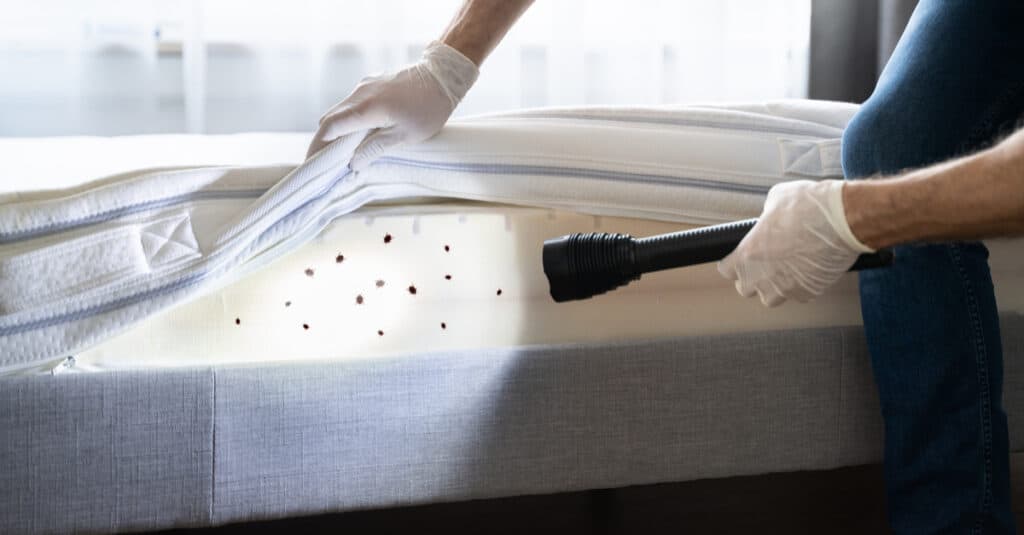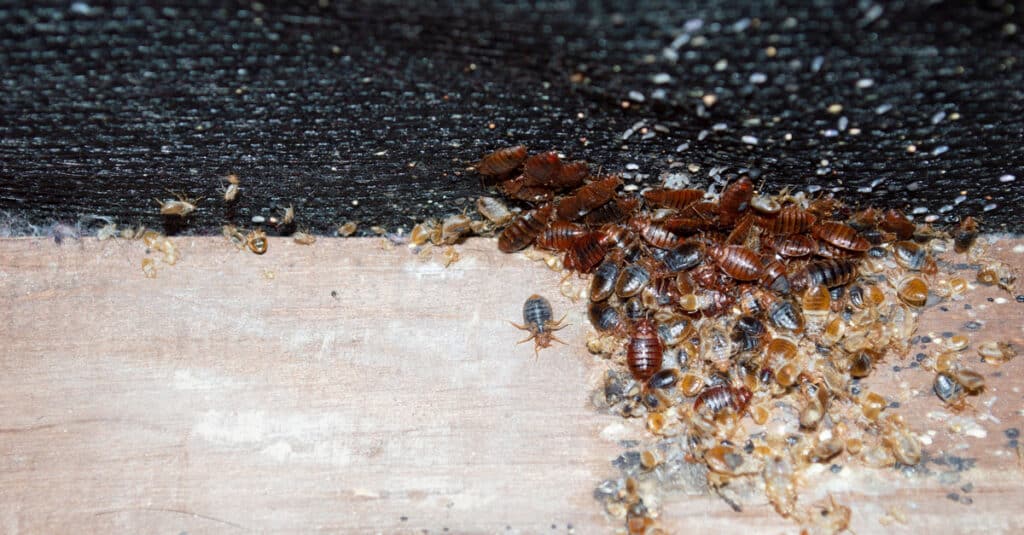Bed bugs are tiny blood-sucking insects that infest human homes and hide in dark, secluded areas. When they feast on blood, their otherwise flat oval-shaped bodies inflate like a balloon and transform from brown to red. Symptoms of their bite include red swelling marks over the exposed areas of the body, particularly around the arms and neck. Once they’ve established a presence in the home, bed bugs will reside in the mattress, walls, and the rest of your sleeping area. This article will cover some important facts about the identification and proper treatment methods for bed bugs that have infected the mattress.
How to Identify Bed Bugs in the Mattress
A bed bug infestation should be fairly easy to identify. One of the most obvious means of identification is to look for signs around the mattress. You will likely notice red stains on sheets where the bed bugs have been crushed by your body as they feed at night. Another potential sign is the dark black spots, about the same size as a pinhead, around the bed. This is bed bug excrement.
You should also lookout for the pale yellow skin that the nymphs shed as they grow progressively larger. Finally, visual identification of live bed bugs is a sure sign of an infestation. The adults’ oval-shaped bodies, which inflate after feeding, are fairly distinctive. They do not jump around like fleas or fly through the air but instead crawl around on the bed and floor. The eggs are small and white, though easy to miss.

©Andrey_Popov/Shutterstock.com
How to Get Rid of Bed Bugs in the Mattress
Bed bugs are very difficult to eradicate. These resilient insects can go a long time without food and hide in secluded spots. It may require thorough cleaning and treatment of the entire living area to completely get rid of an infestation.
In order to protect your mattress and box springs, you should use a protective cover that easily resists tearing and damage. Make sure the covering is somewhat transparent and lightly colored so bed bugs can be easily seen through it. If you desire some extra protection, then you can purchase a covering that has been treated with pesticides by the manufacturer. After using the cover for some time, you should check it regularly for signs of holes and tears. Replace it as needed.
There are several other treatment options you can take to secure your sleeping area from an infestation. Reduce any clutter around and under your bed. Carefully vacuum the seams and fabric (and dispose of the bag immediately after the first use). You can also use a steam cleaner, either wet or dry, to treat the mattress; set the temperature to at least 130 degrees Fahrenheit (that’s 54 degrees Celsius) and use a diffuser to prevent the bugs from scattering immediately upon contact. Keep a detailed record of some basic facts of the cleaning process so you know where the bed bugs are found. Once the room has been successfully treated, keep checking for signs of the pests every few days and clean again as necessary.
While bed mattresses are clearly vulnerable to infestations, they can also be the source of an infestation. If you have recently bought a used mattress (or any other clothing or furniture item), then check and clean it thoroughly before bringing it into the house. This will greatly decrease your chance of developing an infestation in the first place. A new mattress is very unlikely to spread an infestation and doesn’t need to be checked quite as thoroughly.
Ideally, you should attack the pests in multiple ways. One way may not quite get the job done, and you don’t want to play around with bed bugs if you find them for sure. Throw the kitchen sink at them! We have suggestions and products here. Also, don’t rule out calling a professional to eradicate them, and the last case scenario might be throwing out the mattress if it is severe enough.
Bed bugs are persistent, and simply placing traps or changing your sheets is not enough. We recommend a full battery of solutions including spraying, mattress encasement, traps, UV vacuums, bed blockers, and even a mattress replacement if encasement is not effective. Our top picks for the best products to get rid of bed bugs are:
Can You Test a Mattress for Bed Bugs?
There is no way to definitely test your mattress for bed bugs, but an effective alternative is to place a trap or lure near your mattress. This won’t kill many of the bed bugs, but it will allow you to identify the nature and scale of the infestation depending on how many you capture. Bed bug excrements, shed skin, and bloodstains on sheets are also potential signs of a bed bug infestation in the mattress. If you notice blood stains on sheets, it’s not from the puncture wound on your body. Instead, it’s normally from the bed bug being crushed after it’s already full of blood.

©simon berenyi/Shutterstock.com
Can You See Bed Bugs with the Naked Eye?
Yes, bed bugs can be seen with the naked eye. The adults measure about four to five millimeters long (that’s about 0.20 inches). The eggs, by contrast, only measure about a single millimeter. Once they hatch, the nymphs will start out at about the same size, and then they will grow progressively larger after each successive molt. This entire life cycle from eggs to adults takes as little as four to five weeks under the most ideal conditions.
Up Next:
Read more articles to learn information about bed bugs and how to deal with them.
- Bed Bugs Exterminator: How to Pick the Right Company Don’t let just anyone into your home. Follow our suggestions on finding the right exterminators.
- Carpet Beetle vs Bed Bug: What are the Differences? These can be confused, but it’s important to know the difference in order to have the correct fix.
- Do Bed Bugs Fly? Just when you thought the bed bug was bad enough – do they fly?
The photo featured at the top of this post is © Dmitry Bezrukov/Shutterstock.com
Thank you for reading! Have some feedback for us? Contact the AZ Animals editorial team.






